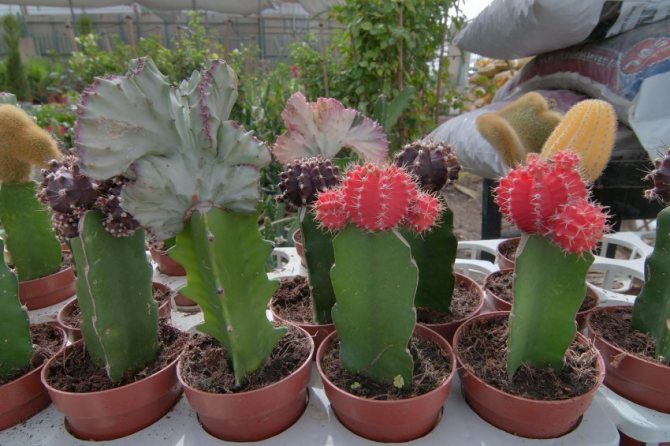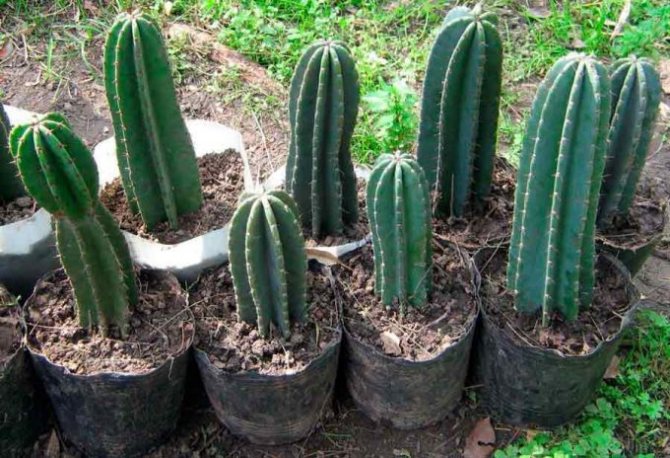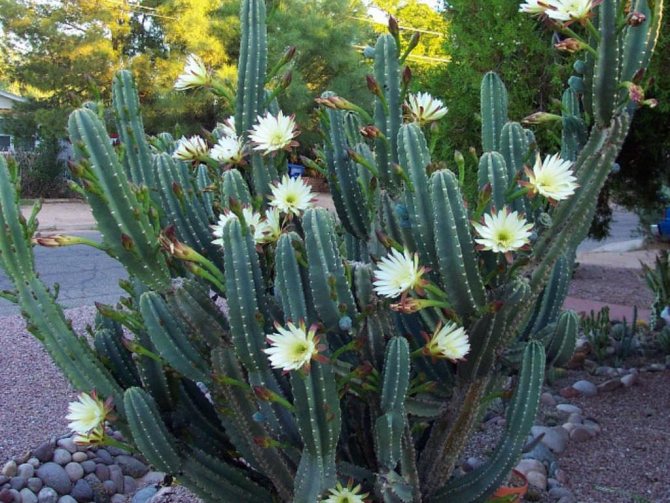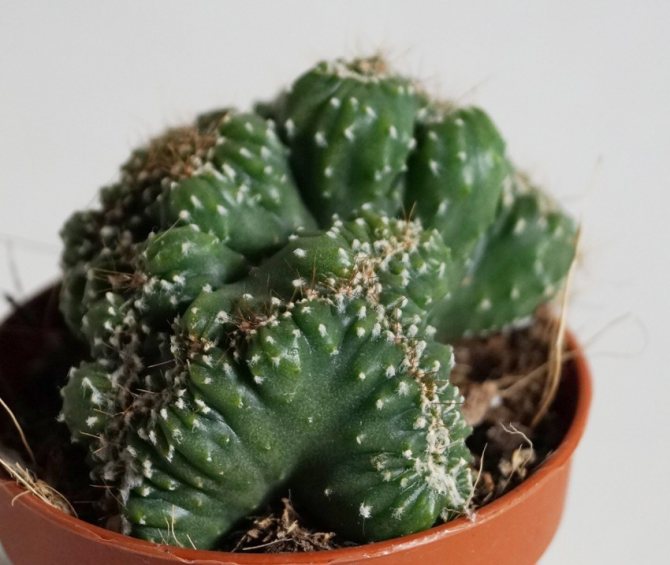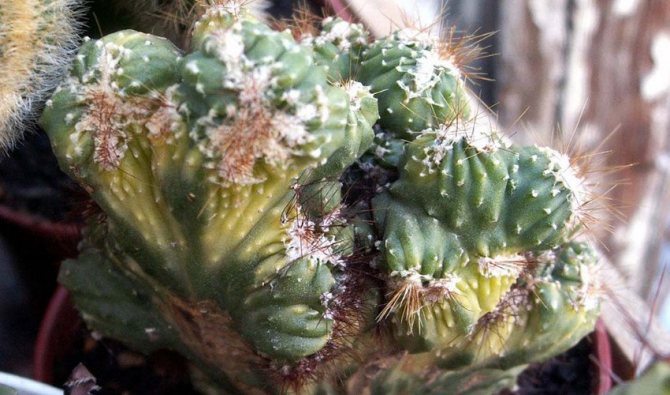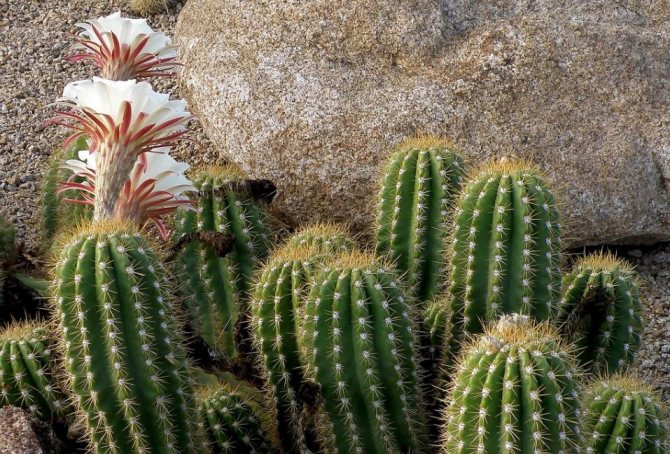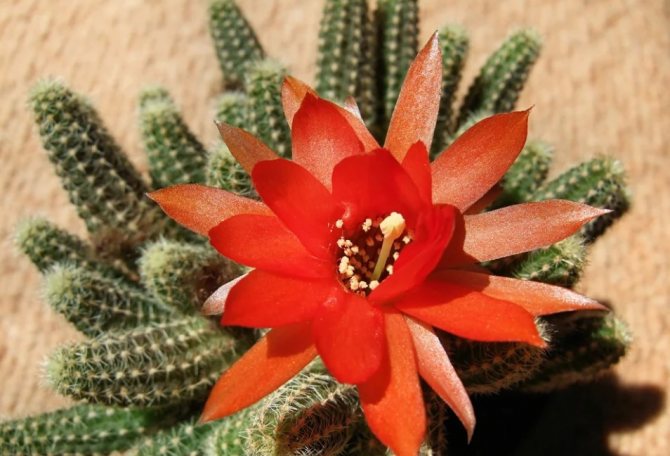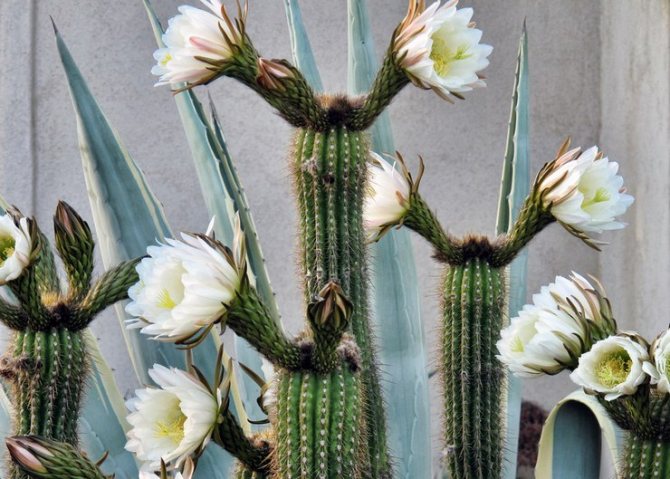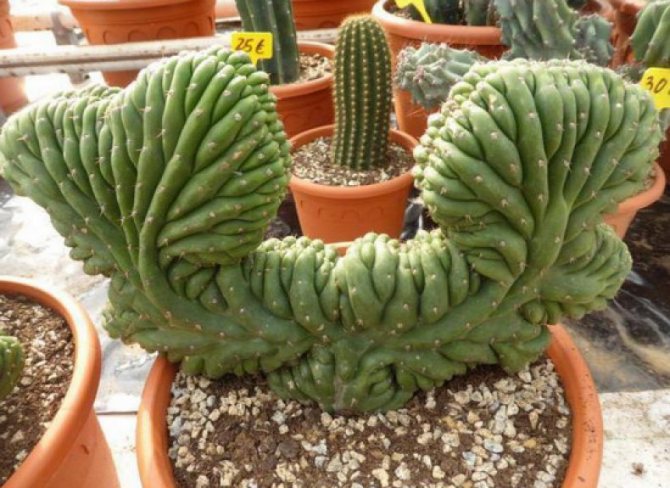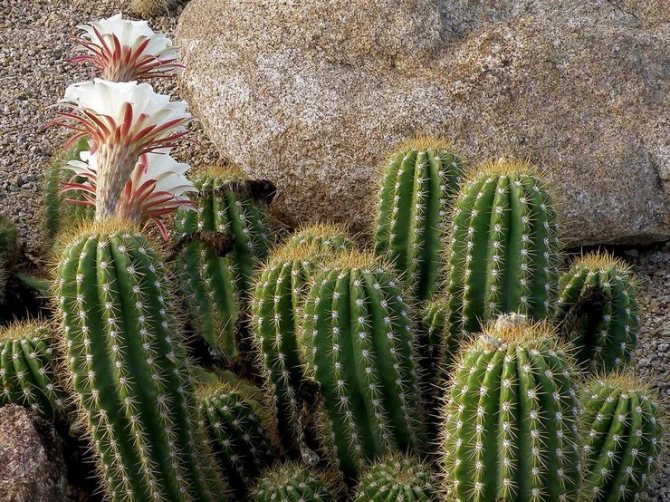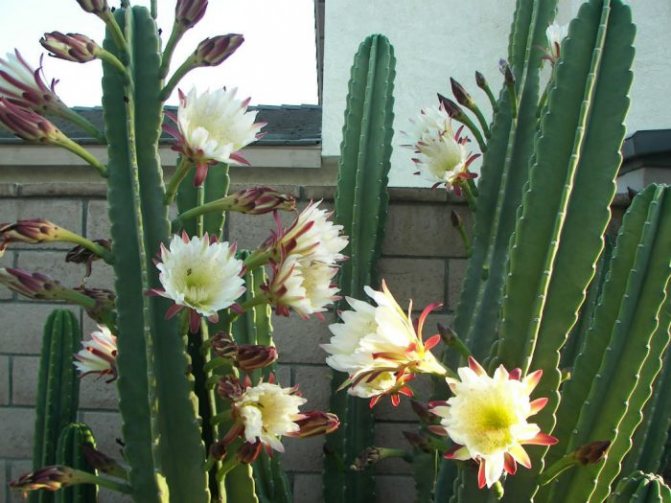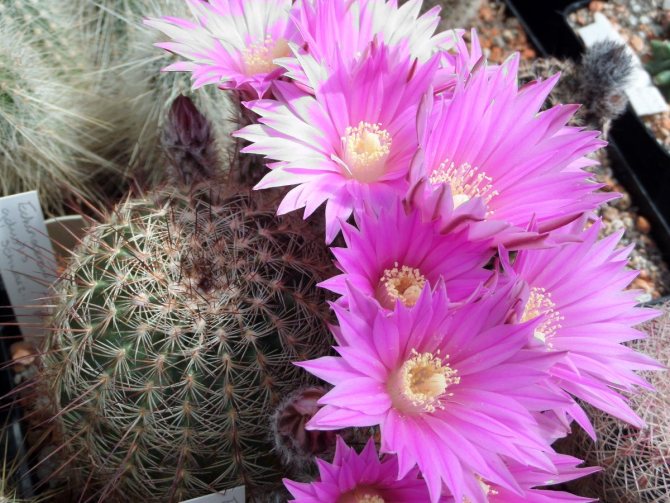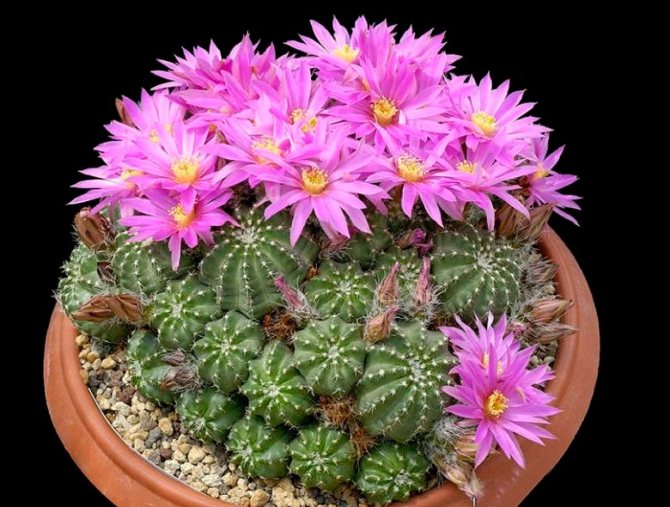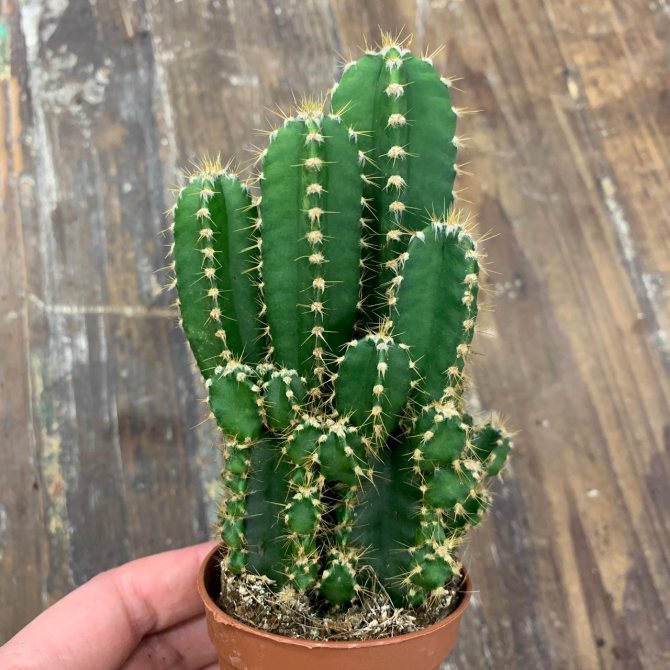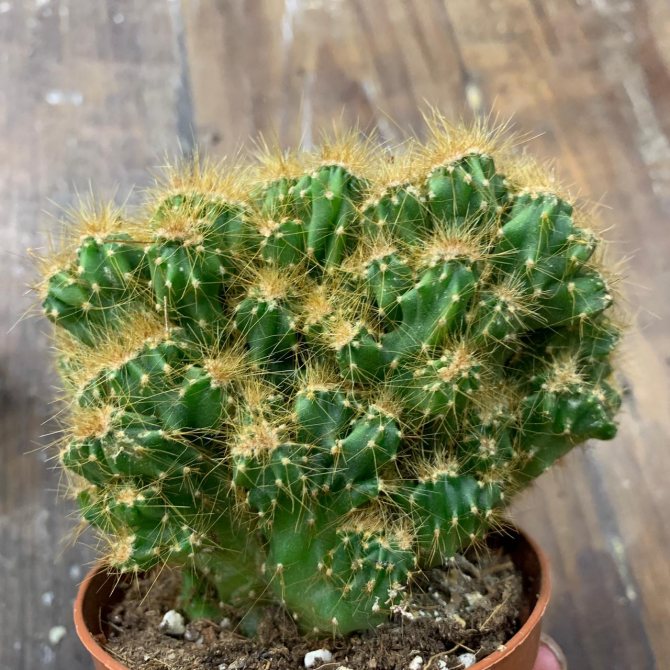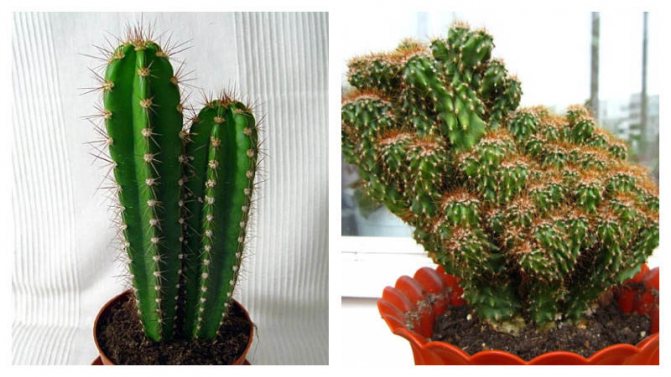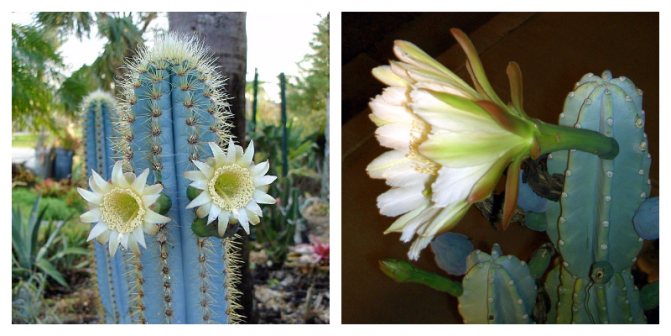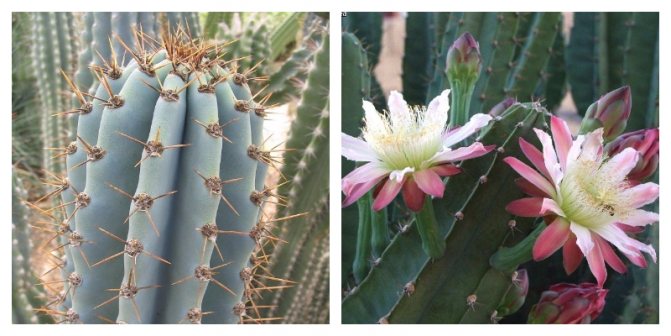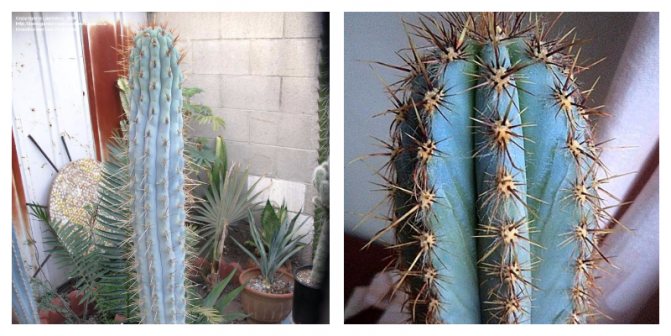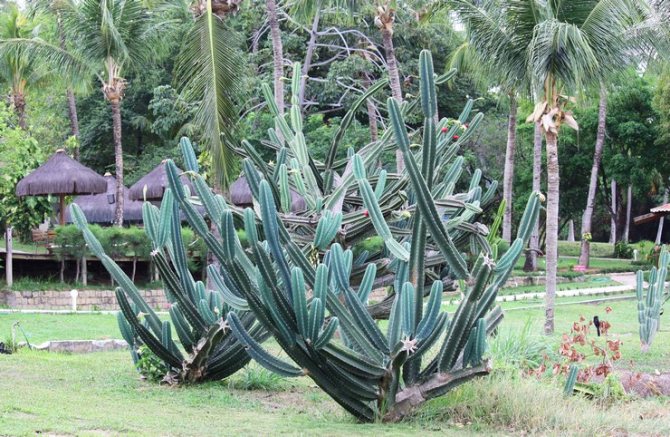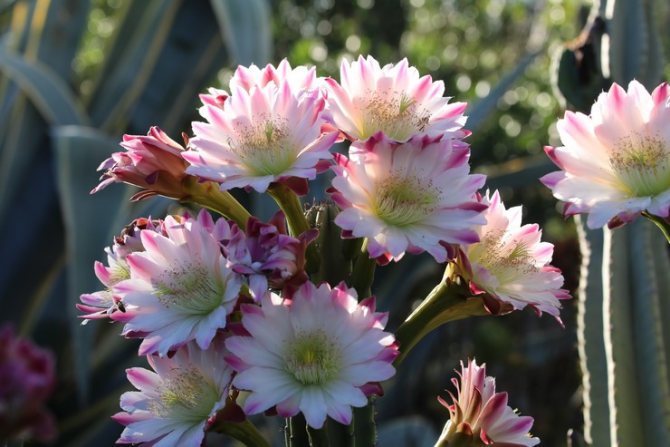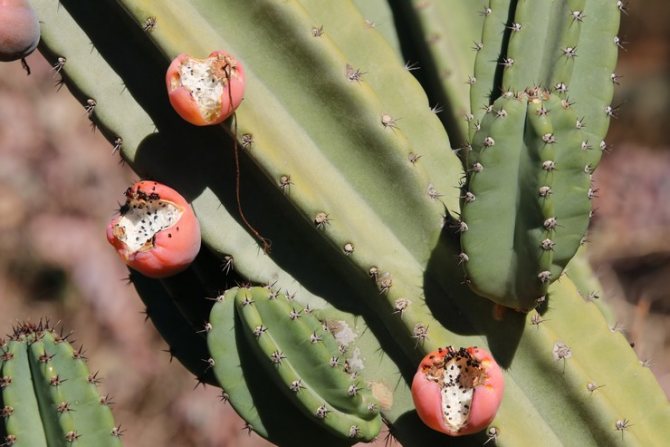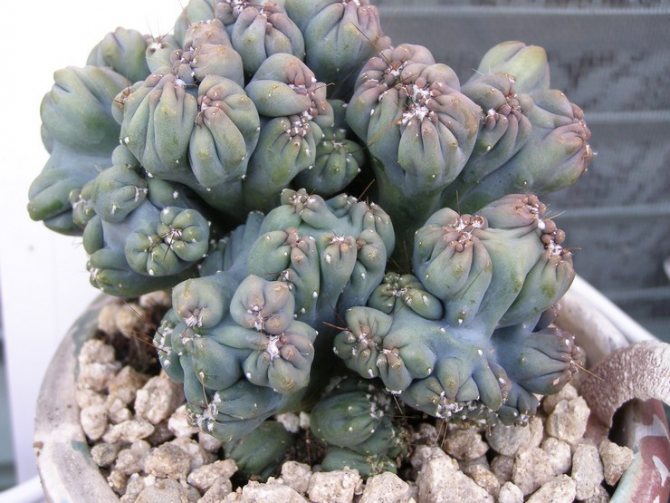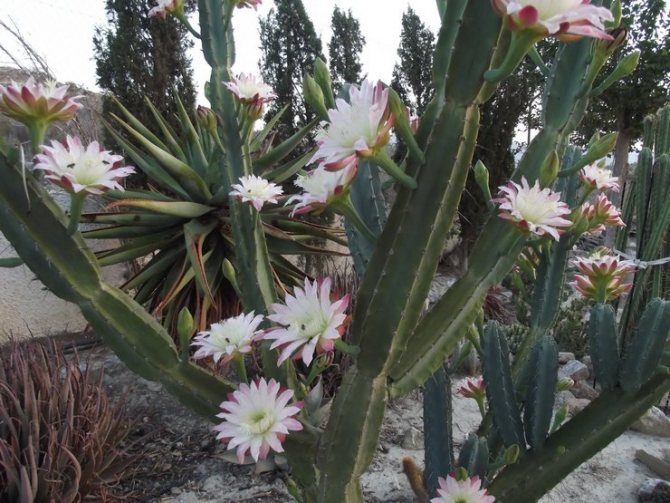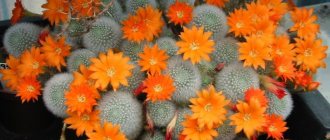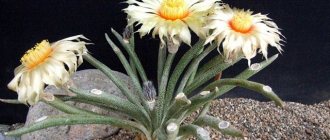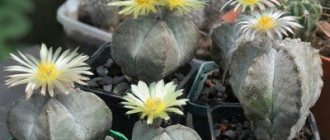Cereus belongs to cactus, in nature it grows to enormous sizes. Only a few species are suitable for growing in an apartment. Cereus won the love of flower growers with its fast growth, large size and spectacular appearance. The development of caring for the Peruvian cereus at home is relevant. This type is most common in indoor floriculture.
Cereus: what is known about him?
Cereus is a succulent like other cacti. A lot of moisture is stored in its juicy trunk. The pulp is hidden under thick skin with a dense wax coating.
South America and Western India are considered the birthplace of Cereus. From the Latin alphabet, the name "Cereus" is interpreted as "wax candle", they are also called "desert torches" and "candlesticks". Such "fiery" names appeared thanks to travelers who set fire to the trunks of old cacti. The dried pieces of plants burned perfectly and illuminated the desert for a long distance.
Cactus in the wild
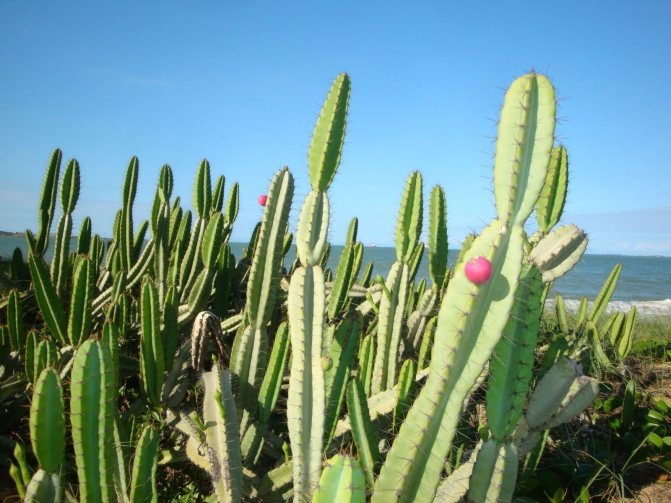
In some species of Cereus, flowers open at night!
In the wild, the cereus is considered a giant. Usually it reaches 6-10 meters in height, and some specimens stretch up to 20 meters. In addition, this cactus is a long-lived record holder that lives up to 300 years. By the age of 50, it reaches its maturity, and between 75 and 100 years, branches begin to appear on the huge trunk. Moreover, the number and location of branches varies greatly, so it is unlikely that it will be possible to find two identical cacti.
Interesting! The "cactus thickets" in the Mexican deserts make an indelible impression on tourists. These are giant pillars up to 15 meters high and half a meter thick, which branch out from the middle in the form of a candlestick.
Signs and superstitions
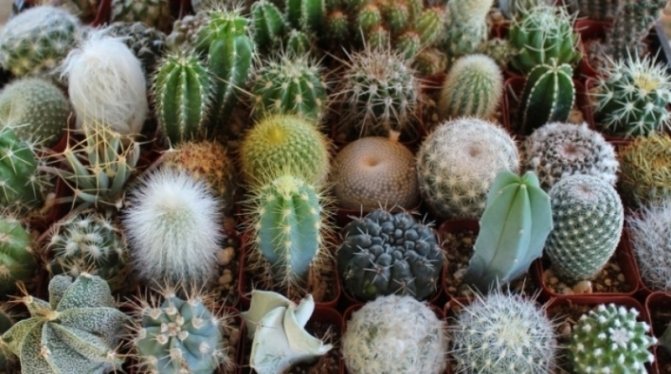

Cactus growers do not believe in bad omens, but they just happily breed a variety of pets.
All cacti, including Cereus, have amazing energy and almost magical properties. They hide the essence of Yang and the essence of Yin, therefore cacti are considered universal helpers for people. For example, a cereus can be placed at the front door to protect the house from negative energies and burglars.
But at the same time, cacti are very fond of places with poor energy. If quarrels and negativity reign in the family, the plant will grow rapidly, actively branch and live a long time. Therefore, do not be discouraged if cacti do not take root in your house: this means that the atmosphere in the house is good.
Who is it for
Cereus cultivation is possible even for beginners. The plant is non-poisonous, its fruits are even eaten. But there are two features that a florist should be aware of:
- Cactus flowers have a very strong aroma. In sensitive people, it can cause insomnia and headaches.
- Cactus needles grow very quickly. If it is in a small room, small children and animals could be injured.
Botanical description and birthplace of the plant
Cereus (lat. Cereus) is a giant among cacti, its height is 6-10 m, there are twenty-meter representatives. It breaks records in life expectancy, since it can grow in nature up to 300 years.
In total, there are 50 species of cereus, common in South and Central America, West Indies.Most of them are tall, well-branching shrubs, there are undersized and creeping plants (they cling with the help of lateral processes).
Cereus is characterized by a cylindrical structure of shoots, divided into several well-defined edges. Against the background of the green-gray shade of the stems and shoots, dark brown, almost black spines stand out favorably, although at first they are almost white. The name of the plant is translated from Latin as "wax candle".
Cereus is perfect for indoor cultivation: it is not picky, reproduces well, grows quickly and has established itself as an excellent stock. A highly decorative plant will decorate a room, a winter garden, a showcase. Cereus is often used to create cactus slides.
Cereus bloom
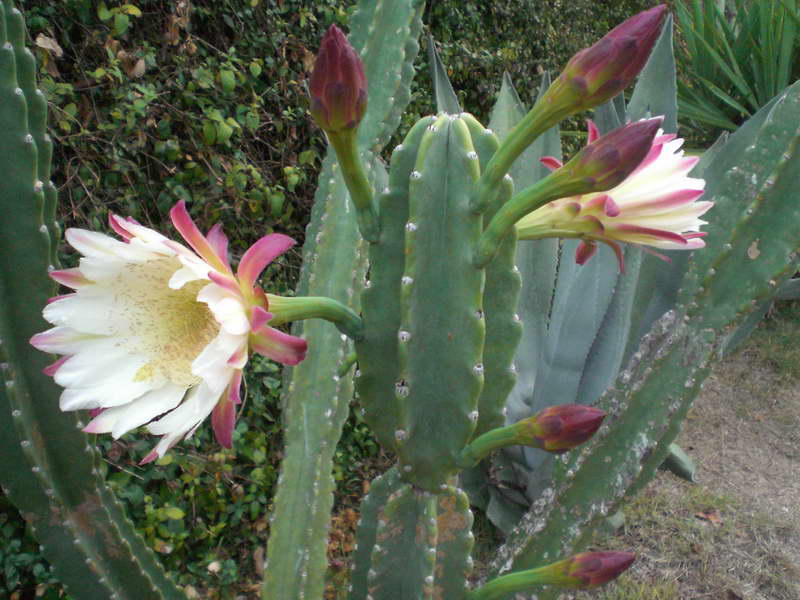

How Cereus blooms Peruvian photo
In nature, Cereus blooms regularly between May and June, the bush adorns many corollas. In indoor conditions, it can bloom even in the fall, of course there are not so many corollas. Flowers are located laterally (on the side of the shoots). They are large, the petals are snow-white, beige or pinkish, the core is golden.
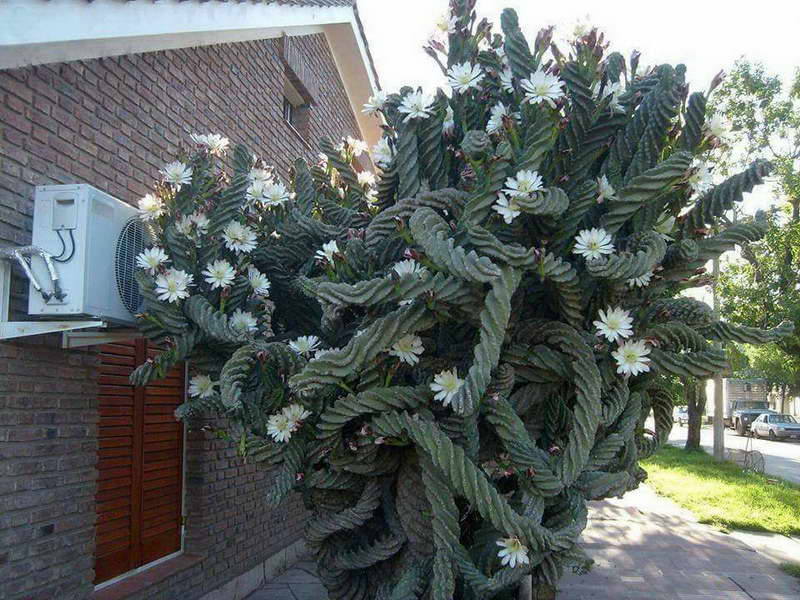

How Cereus blooms spiral photo
A single flower lives no more than a day, but manages to give a heady aroma. It is intense, similar to vanilla, so ventilate the area if susceptible to odors.
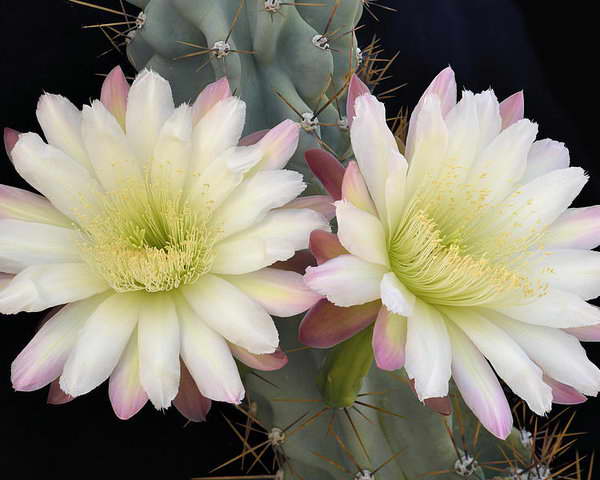

Cereus Peruvian monstrous form as it blooms photo
Fruits in the form of berries of red or yellow color, they can be eaten.
Popular species and varieties: names, photos and descriptions
Cereus has more than 50 species - from miniature to gigantic. The most popular varieties are striking in their variety.
Peruvian Cereus (Uruguayan, or Peruvianus)
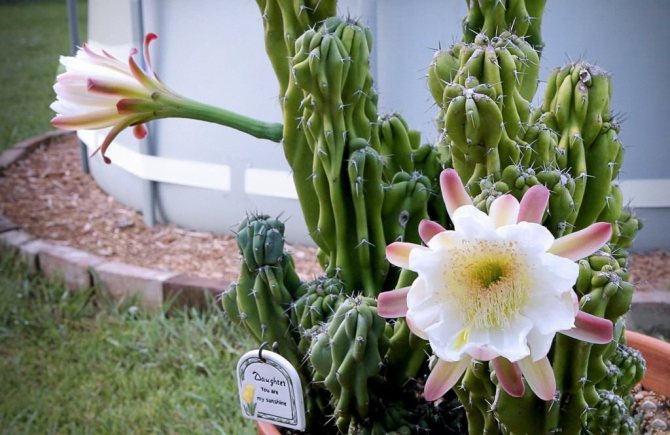

Peruvian Cereus blooms with flowers with an unpleasant smell, but after that edible berries are formed on it
It is also called "rocky" because of its original shape, similar to rocks. The stem is gray-green.
Separately, it should be said about such a form of Peruvian cereus as monstrose (also monstrose, or monstrozus). Under indoor conditions, this species does not bloom, however, its appearance is diverse, because many hybrids have been created based on it.
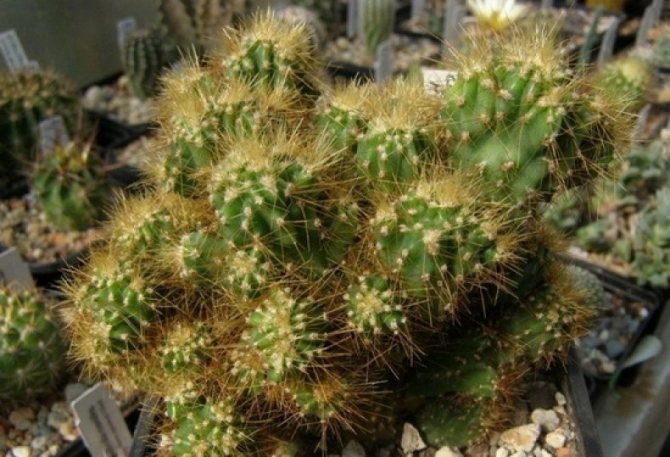

This is the most popular form of cereus among flower growers, which does not require as careful care as others.
Spiral
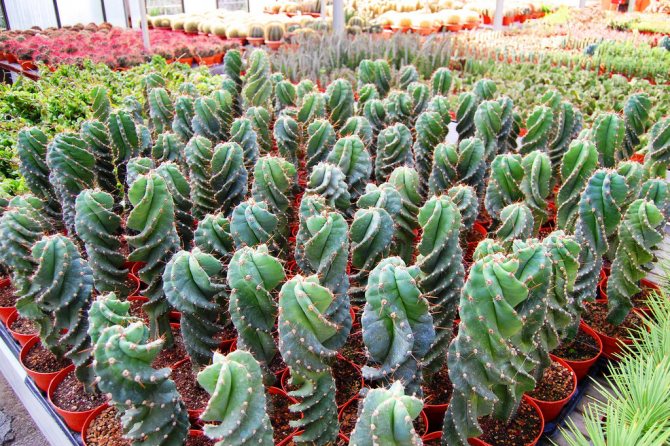

Flowers on a spiral-shaped cereus appear on the sides
Thick stems are twisted in a spiral with spines 2-3 cm long. The color of the plant is green with the addition of brown, the flowers are pinkish-white.
Azure
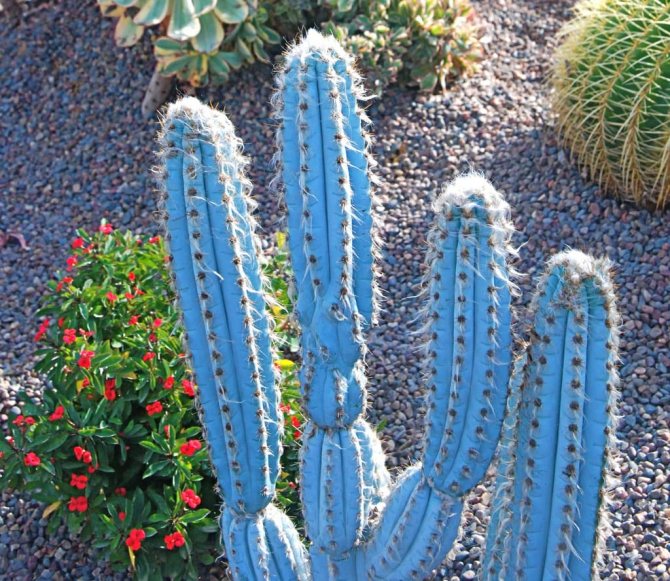

The flowers of this form are large, up to 10 cm in diameter.
It is called so because of its pale blue color. Many branches, fragrant white flowers.
Paolina
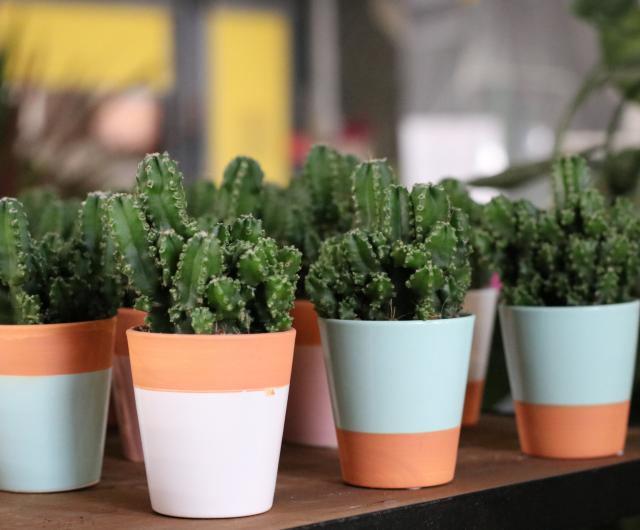

Paolina blooms only in adulthood, forming coral-colored fruits after flowering
Young plants have a light green color, with age it becomes richer.
Validus
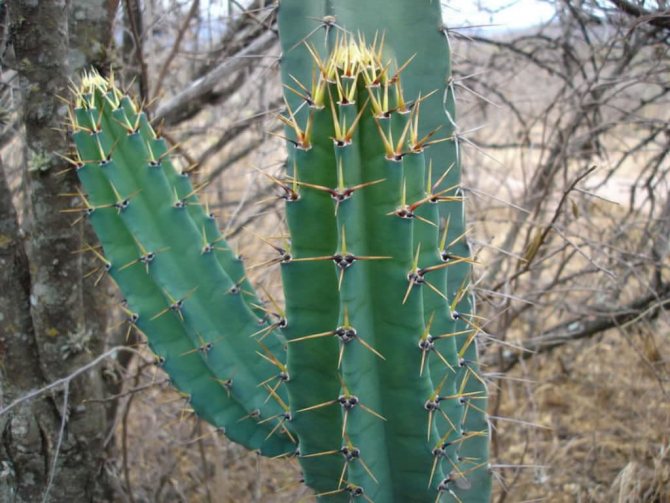

The flowers of this variety are white or red, pinkish at the base
Stems are bluish in color, each has 4 to 8 ribs. Milky flowers.
Forbes
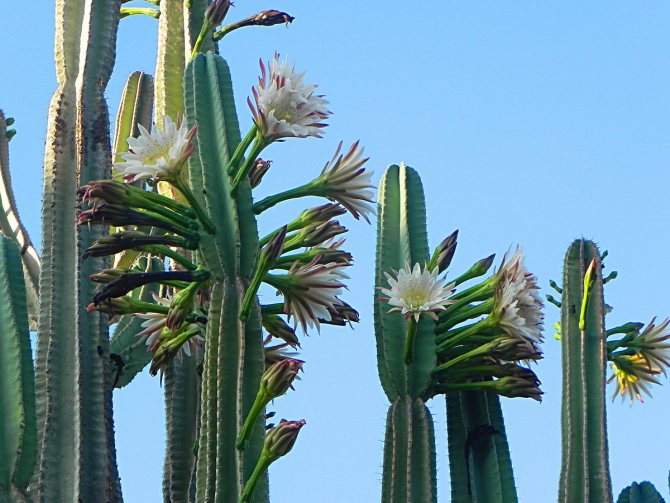

For this type, the soil must be acidic, loose and nutritious.
A cactus that looks like a tree or shrub with many branches. In adulthood, it has a height of 2 m and a diameter of 0.5 m. Flowers are medium-sized, white, with a red core.
California giant


This variety is in the top 3 of the largest cacti on the planet.
The largest member of the genus Cereus and the largest cactus in the world. The average height is 15 m, and the largest specimen is 25 m.
Yamakaru
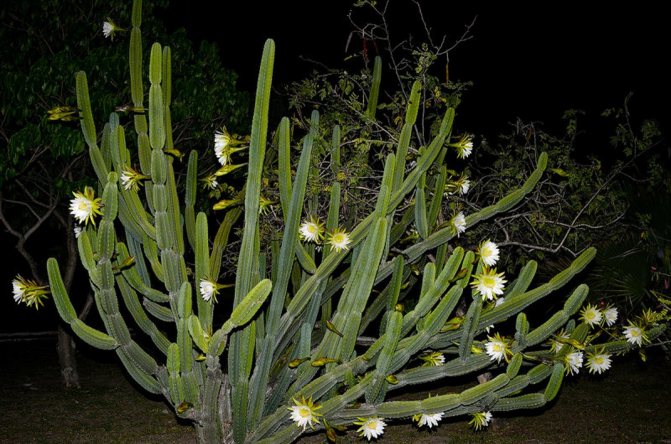

After flowering, red fruits are formed on this species.
The standard stem is oblong with many light needles. Flowers open only at night and reach 20 cm in diameter.
Flowering features
Flowering occurs in the spring and summer, in May and June.Cereus bloom only at night. Blooming flowers, located on the sides of the stems, are white or pink with a golden tint at the core. There is also an aroma in flowers, usually vanilla aroma. At home, the cactus, unfortunately, rarely blooms. For successful growth and flowering, a special temperature, illumination and a certain air humidity are required, which is rather difficult to provide at home.
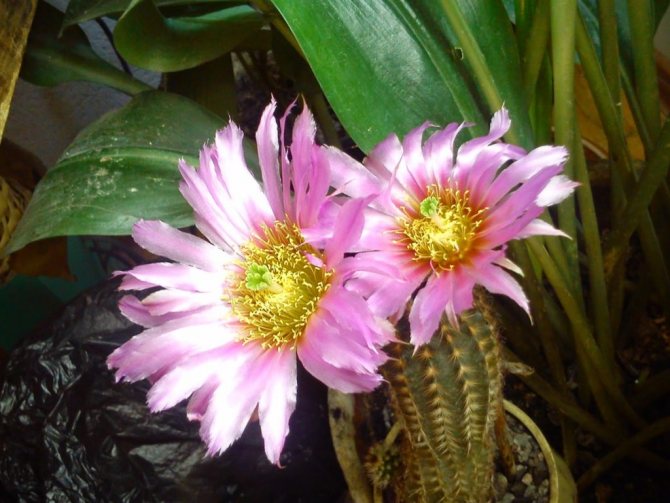

Growing a cereus: basic requirements
Like most cacti, cereus are unpretentious in terms of maintenance and care. But there are some recommendations that a beginner cactus grower should take into account.
The soil
For good growth and development, cereus needs acidic or neutral soil; in an alkaline environment, it will not survive. If you are preparing the substrate yourself, add river sand and crushed brick to it. When buying a ready-made composition, you should stop at a soil mixture for cacti or succulents.
Lighting
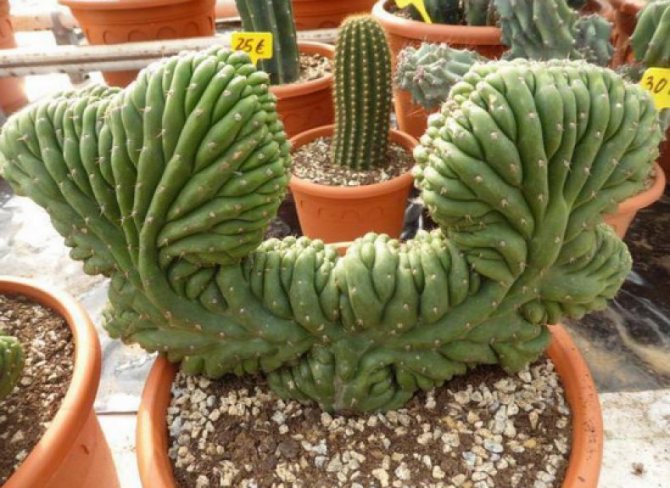

Monstrous forms will also have to be supplemented at least sometimes.
For flowering, the plant needs abundant light all year round. This is especially important in the cold season, when buds are tied on the cactus. There are several rules:
- the container with the plant should stand on the window from the southeast or south side (where there is more sun);
- diffused light is required, since direct rays of the sun can leave burns;
- in autumn and winter, cacti must be illuminated with phytolamps (daylight hours should be 10 hours);
- after winter, the cereus should gradually get used to the bright spring sun, and at lunchtime in the summer, the cactus should be hidden under a tulle curtain.
Air temperature
The cactus tolerates heat well, but at the same time it needs regular ventilation. In summer, it is better to keep it on an open balcony or veranda; from late autumn until spring, the indoor air temperature should be maintained from 8 to 12 ° C.
Main types
There are many varieties of cereus... The most popular of them are:
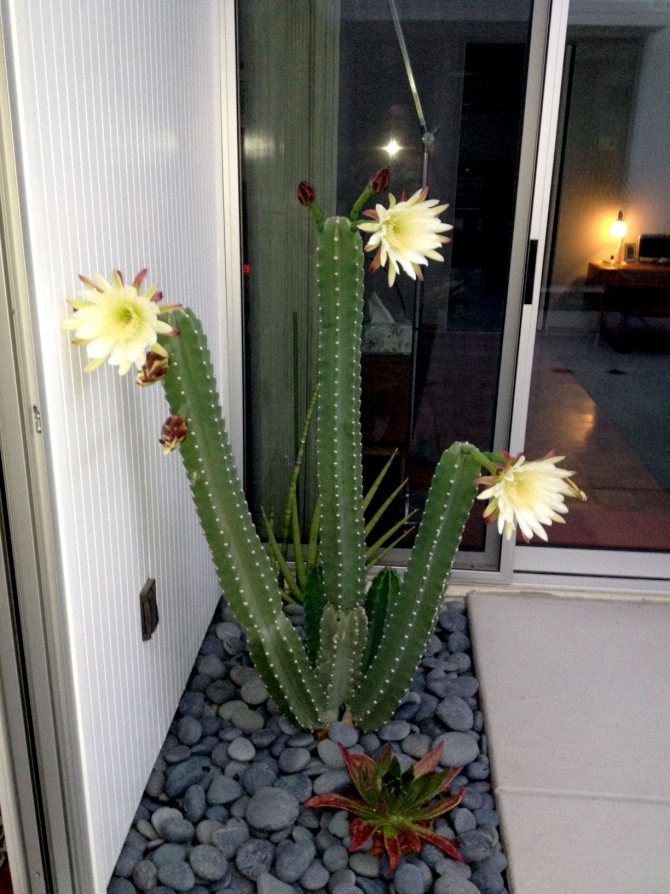

Giant. This cactus is called the king of the deserts for its enormous size. It mainly grows in the Arezon Desert, Sonora and Mexico. The height of this variety of Cereus reaches 20 m, and the height is 70 cm. It is very resistant to prolonged drought. Not suitable for home growing.- Peruvian. In its natural environment, the Peruvian cactus cereus reaches 12 meters, but indoors, in rare cases, it grows up to 2 m. It is characterized by a not very pleasant aroma.
- Hamakaru (Yamakaru). The stem height reaches 12 meters. This cactus is characterized by abundant branching. In pots it grows up to 12 m.
Most varieties of Cereus have a pronounced odor - unpleasant or pleasant. In people with hypersensitivity, this culture can cause insomnia.
Home care
To make it easier to tame a southern plant, follow these tips for caring for it.
Watering
In spring and summer, watering should be moderate and frequent, but without waterlogging. Compared to other cacti, Cereus requires more water. In late autumn and winter, it is enough to water it once a month.
Top dressing
From April to July, succulents need to be periodically fed with a liquid complex composition. The procedure is performed every 30–35 days.
Air humidification
It is not necessary to artificially increase the humidity in the room, but it will not hurt to irrigate the plant from a spray bottle in the summer to remove dust. A damp brush can be used instead of a sprayer. After a shower, the cactus should not be placed in the sun, it should dry out a little.
Transplant (description and video)
The growing cereus is transplanted into a wider and deeper pot. In the future, a mature plant is transplanted every 2-3 years; it is better to carry out the procedure in early spring. The bottom of the new pot must be covered with a drainage layer of expanded clay, pebbles, brick chips, foam (you can use several components or mix everything).
There is no need to fertilize the soil for the next 2-3 weeks after transplanting, since the plant takes nutrients from the substrate.
Diseases and pests of cereus
Pests are not afraid of cactus thorns, so they actively settle on its juicy stems. Cereus is threatened with:
- Shields. These are dark growths on the stems. For treatment, it is necessary to soak a cotton swab with a solution of laundry soap and try to erase the stains, then treat it with an insecticide solution.
- Spider mites. Small dark red pests that suck out the juice, after which the cactus dries up. They cover the plant with a thin white cobweb. To cure cereus, it is wiped with a cotton swab with soap, then sprayed with an infusion of onion peel, garlic or tobacco, acaricide is also suitable.
- Mealybug. The cactus is covered with small white worms that leave a sticky coating. You can remove pests with a cotton pad moistened with a solution of laundry soap. Then you need to treat the plant with an insecticide, Aktara or Fitoverm will do.
Pest and disease control
It is recommended to periodically carry out preventive treatment with fungicides and insecticides. The first signs of disease or pest infestation often appear at the bottom of the stem or folds.
| Mealybug | Formation of white patches. The surface of the spots looks fluffy. | The plant and the soil around it are repeatedly treated with insecticides. Transplantation into fresh sterile soil is recommended. |
| Spider mite | Detect by small red spots and a thin cobweb. In the later stages of the lesion, yellowish dead spots are formed. | Spraying with insecticides "Aktara", "Aktellik". |
| Shields and false shields | Small insects with a convex "shell". They suck out the juice from the plant, leading to its death. | As in previous cases, insecticide treatment is carried out. |
| Rot | Fungus. It is characterized by the appearance of softened brown spots on the stem. | With minor damage, the decayed areas are cut out with a sharp knife, treated with alcohol, and sprinkled with coal powder. They are transplanted into new soil. Watering is limited. |
Cereus are often included in short plant compositions. They also look good as an independent plant in floor pots.
Growing problems
As it grows, Cereus can fall off, rot, become stained or dry out. The reason is usually one of the two main enemies of the cereus:
- Waterlogging. In a too humid environment, fungi will certainly develop, causing rotting. They can be identified by the dark spots on the trunk. If the damage is severe, the cactus dies. As soon as you see the first signs of rotting, immediately remove the cactus from the pot. It is necessary to shake off the soil and replace it with a new one, remove damaged parts and treat the cactus with a fungicide.
- Hypothermia. Cork spots on the shoots indicate that the plant is freezing. You need to rearrange it in a warm place. If the cactus is on the balcony in winter, it is recommended to put foam plastic, ceiling tiles or a piece of other heat-saving material under it so that the roots do not freeze through.
Uses of Night Cereus
Cereus jamacaru is a hardy rootstock and grows quickly. Therefore, it is widely used for landscaping winter gardens, greenhouses. They decorate the halls of premises, shop windows with it. They also create decorative cactus slides. Pillar-shaped specimens are used to make a live thorny hedge. Low-growing options are placed in apartments on window sills. Cactus wood is used to make polished ornaments and fine items. Barrels are also actively used as fuel and building material.
Reproduction methods
There are two ways to grow Cereus at home: by seed (as in the wild) and by cuttings (the easiest way).
Seeds
Sowing takes place in the spring.To grow a cereus from seeds, you must:
- Fill a wide, shallow container with a mixture of peat and sand or a commercially available cactus formula.
- Smooth out the substrate and spray with water from a spray bottle. Sprinkle seeds on top.
- Place in a warm place with air temperature from 22 ° C and diffused light. Spray the ground as it dries, but avoid waterlogging. Seedlings must be protected from drafts.
- Germinating seedlings must be thinned out with tweezers. When the first thorns appear (after about 3-4 weeks), the cactus can be transplanted.
Cuttings
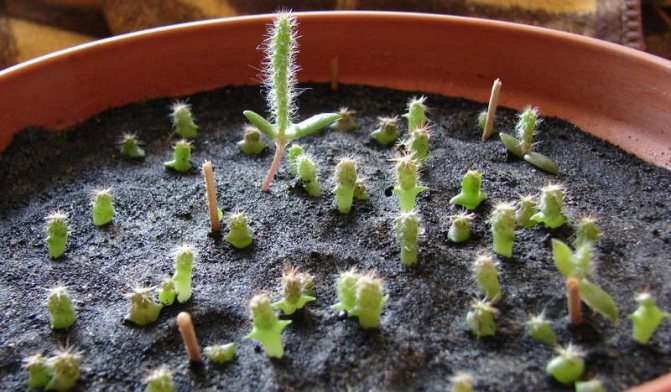

Not all cuttings will be accepted, so they need to be planted at least a dozen
If there is already an adult plant, the easiest way is to propagate it by cuttings. For this you need:
- Gently break off a few branches from the trunk and dry until a crust appears.
- Place in separate small pots as for mature plants.
- Wait for rooting (about 2-4 weeks), after which the cacti should begin to actively grow.
The best time for rooting is from early spring to mid-summer.
Cereus is a wonderful houseplant that will delight its owner with unusual shapes and fragrant flowers. But no matter which variety you choose, it is important to provide it with decent conditions for growth and development.


